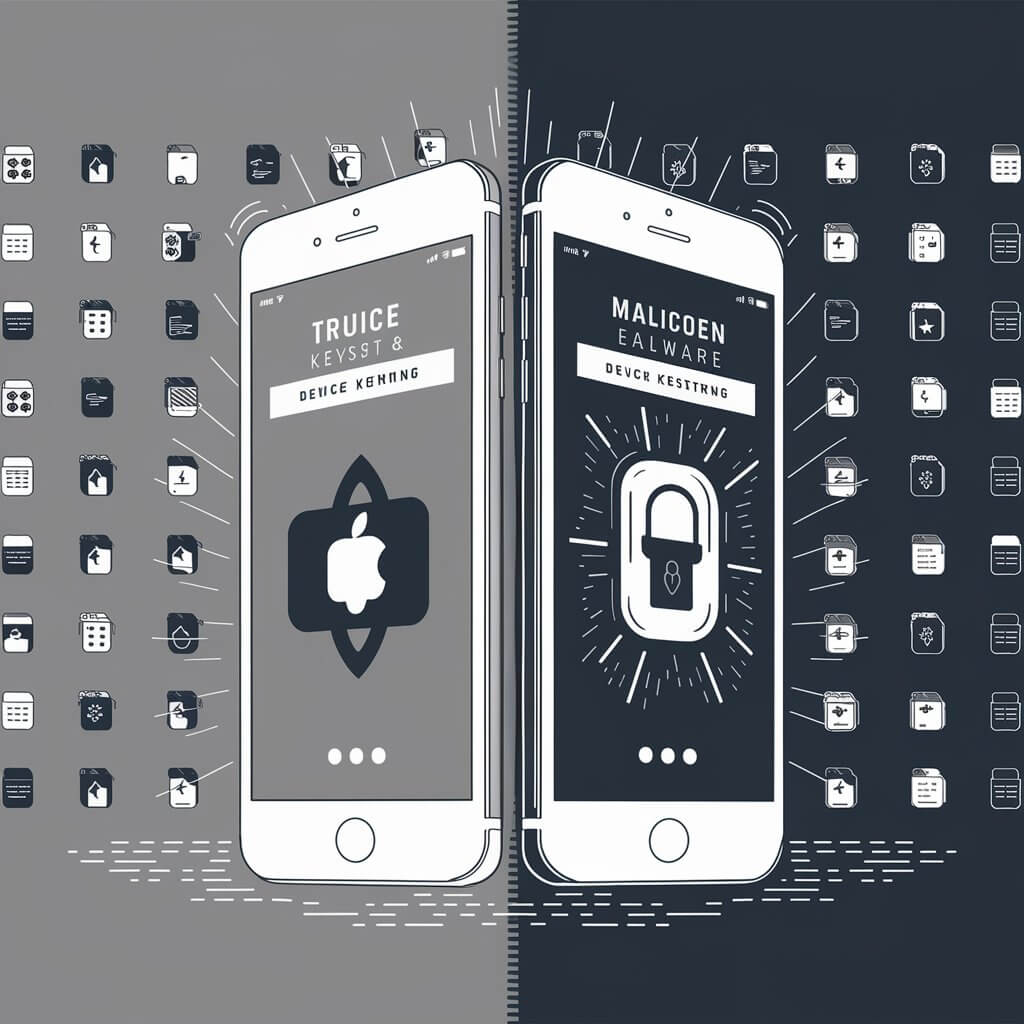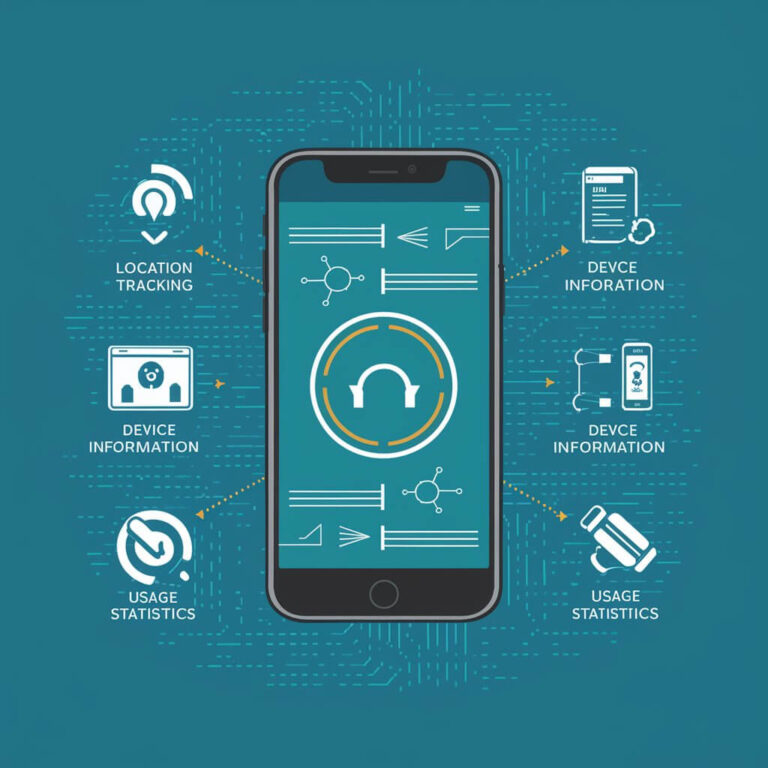Devicekeystring Explained: Legitimate App Vs. Malware Disguise
Understand the difference between a genuine DeviceKeyString, crucial for securing Wi-Fi interactions with external devices, and a potentially harmful version. Legitimate usage enhances security, while malware disguised as DeviceKeyString can jeopardize your device and personal data. Pay attention to signs like battery drain, odd notifications, or unfamiliar apps. Genuine apps work smoothly in the background without disturbances, unlike malware. Act swiftly if you suspect foul play by scanning with trusted security tools. Address threats promptly to safeguard your information and device. Additional insight awaits for a comprehensive understanding of DeviceKeyString variations.
Key Takeaways
- Legitimate DeviceKeyString enhances Wi-Fi security discreetly on select Android devices.
- Malicious versions drain battery, send unwanted notifications, and may appear as uninstalled apps.
- Swiftly address suspicions of malicious DeviceKeyString with security scans and possible factory reset.
- Differentiate by monitoring app list for unusual behavior and ensuring smooth, silent operation.
- Respond promptly to malware by running reputable security scans, deleting associated files, and considering a factory reset.
Understanding DeviceKeyString
Understanding DeviceKeyString involves distinguishing between its legitimate system application form and its potentially harmful malware form by observing its behavior on your device. The functionality of DeviceKeyString as a legitimate system app is to enhance the security of Wi-Fi connections by facilitating secure interactions with external devices. However, the presence of DeviceKeyString as malware poses significant potential risks to your device’s security and your personal data.
The security implications of encountering malicious DeviceKeyString include unauthorized access to critical phone functions such as the camera, storage, and location. This unauthorized access can lead to severe breaches of privacy and data theft.
The user impact of dealing with malware disguised as DeviceKeyString can range from increased battery drain, unexpected pop-up notifications, to overall device sluggishness.
To mitigate these risks, it’s crucial to promptly identify and remove any suspicious instances of DeviceKeyString. Running a scan with reputable security software is recommended to detect and eliminate any malware masquerading as DeviceKeyString.
Taking swift action to address this issue is essential to safeguard your device and personal information from potential harm.
Legitimate DeviceKeyString Features
Legitimate DeviceKeyString functions as an essential system application on select Android devices, primarily Samsung phones, operating discreetly in the background to enhance the security of wireless connections with external devices.
Its features and benefits include:
- Enhanced Security Measures: DeviceKeyString strengthens the security of Wi-Fi connections by generating unique keys for pairing with external devices, reducing the risk of unauthorized access.
- Efficient Functionality: This application works seamlessly in the background without causing disruptions to your device’s performance, ensuring a smooth user experience.
- Optimized Resource Usage: DeviceKeyString is designed to consume minimal resources, preventing battery drain or slowdowns on your device.
- Various Usage Scenarios: From connecting to Bluetooth speakers to pairing with smart home devices, DeviceKeyString facilitates secure and reliable communication between your phone and external gadgets.
Identifying Malicious DeviceKeyString
To distinguish potentially harmful software camouflaged as ‘DeviceKeyString‘ from its authentic counterpart, focus on specific indicators such as battery drainage, unexpected notifications, or its presence in the app list. Malicious versions of DeviceKeyString often exhibit common behaviors such as unusually high battery consumption, frequent and unwanted notifications, or appearing as an app you didn’t install. These are strong identifying indicators that suggest security risks associated with the presence of malware.
If you suspect that ‘DeviceKeyString’ on your device is malicious, it’s crucial to take immediate action. Start by running a scan with reputable security software to identify and confirm any threats. If malware is detected, follow the recommended removal process provided by your security software. In severe cases, a factory reset may be necessary to completely eliminate the malicious software.
To prevent such instances in the future, ensure you only download apps from trusted sources and regularly update your device’s security software for enhanced protection against malware.
Differentiating Between Legitimate and Malware
Differentiating between a legitimate DeviceKeyString and malware requires careful observation of specific behaviors and indicators on your device.
To help you distinguish between the two, consider the following:
- Common Misconceptions: Don’t assume that all instances of DeviceKeyString are malicious; some are legitimate system applications.
- User Experience: Legitimate DeviceKeyString should operate silently in the background without causing disruptions to your device’s performance.
- Security Risks: Malware disguised as DeviceKeyString may have permissions to access sensitive functions on your phone, posing a risk to your data and privacy.
- System Impact: Keep an eye out for unusual battery drainage, pop-up notifications, or unauthorized access requests, as these could indicate malware presence.
To prevent falling victim to malware posing as DeviceKeyString, regularly monitor your app list for any suspicious activity, run security scans using reliable software, and promptly remove any detected threats following the instructions provided.
Responding to Malware Detection
When detecting malware disguised as DeviceKeyString, prompt action is crucial to mitigate potential risks to your device and personal data. If you suspect malware, handle the detection by first running a scan using reputable security software.
Security software recommendations include well-known options like Avast, McAfee, or Norton. Once malware is identified, follow the removal instructions provided by your security software. These instructions may involve isolating the malware, deleting associated files, and potentially performing a factory reset on your device to ensure complete removal.
To prevent future infections, consider implementing prevention tips such as avoiding downloading apps from unverified sources, keeping your device’s operating system and security software up to date, and being cautious of suspicious links or attachments in emails or messages.
Frequently Asked Questions
How Can I Prevent My Device From Being Infected by Devicekeystring Malware?
To prevent devicekeystring malware infection and ensure device security, verify app legitimacy by checking for signs of abnormal battery drain, pop-up notifications, or the app in your list. Protect your data with regular scans and swift removal of suspicious apps.
Can a Legitimate Devicekeystring App Be Removed or Disabled?
Yes, a legitimate DeviceKeyString app can usually be disabled or removed. However, doing so may affect your device’s security features. To prevent malware, focus on detecting warning signs, enhancing device security, and protecting your data privacy.
Is It Possible for Devicekeystring Malware to Access My Personal Data?
Yes, devicekeystring malware poses a significant risk to your data privacy. Malicious apps can access personal information through permissions granted. Strengthen device security by monitoring app permissions, implementing security measures, and staying vigilant against cyber threats for effective malware prevention and data protection.
Can Devicekeystring Malware Be Detected by Common Antivirus Software?
Antivirus effectiveness in detecting ‘DeviceKeyString’ malware varies. Detection methods rely on signature databases and heuristic analysis. To prevent malware, use reputable security software. Signs of infection include battery drain, unexpected notifications, and unauthorized access to personal data.
Are There Any Specific Signs to Look for if My Device Has Been Infected by Devicekeystring Malware?
If you suspect devicekeystring malware, watch for malware indicators like unusual behavior, performance issues, suspicious permissions, or data breaches. Check your device for signs of infection to protect your data and privacy.
Conclusion
In conclusion, being able to distinguish between a legitimate DeviceKeyString app and potential malware disguise is crucial for ensuring the security of your Android device.
By understanding the key features of the genuine application and recognizing the signs of malicious activity, you can take proactive measures to protect your device from unauthorized access and potential harm.
Stay vigilant, stay informed, and stay in control of your device’s security.






